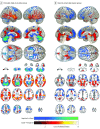Prediction Models of Functional Outcomes for Individuals in the Clinical High-Risk State for Psychosis or With Recent-Onset Depression: A Multimodal, Multisite Machine Learning Analysis
- PMID: 30267047
- PMCID: PMC6248111
- DOI: 10.1001/jamapsychiatry.2018.2165
Prediction Models of Functional Outcomes for Individuals in the Clinical High-Risk State for Psychosis or With Recent-Onset Depression: A Multimodal, Multisite Machine Learning Analysis
Erratum in
-
Error in Byline.JAMA Psychiatry. 2019 May 1;76(5):550. doi: 10.1001/jamapsychiatry.2019.0618. JAMA Psychiatry. 2019. PMID: 30942832 Free PMC article. No abstract available.
Abstract
Importance: Social and occupational impairments contribute to the burden of psychosis and depression. There is a need for risk stratification tools to inform personalized functional-disability preventive strategies for individuals in at-risk and early phases of these illnesses.
Objective: To determine whether predictors associated with social and role functioning can be identified in patients in clinical high-risk (CHR) states for psychosis or with recent-onset depression (ROD) using clinical, imaging-based, and combined machine learning; assess the geographic, transdiagnostic, and prognostic generalizability of machine learning and compare it with human prognostication; and explore sequential prognosis encompassing clinical and combined machine learning.
Design, setting, and participants: This multisite naturalistic study followed up patients in CHR states, with ROD, and with recent-onset psychosis, and healthy control participants for 18 months in 7 academic early-recognition services in 5 European countries. Participants were recruited between February 2014 and May 2016, and data were analyzed from April 2017 to January 2018.
ain outcomes and measures: Performance and generalizability of prognostic models.
Results: A total of 116 individuals in CHR states (mean [SD] age, 24.0 [5.1] years; 58 [50.0%] female) and 120 patients with ROD (mean [SD] age, 26.1 [6.1] years; 65 [54.2%] female) were followed up for a mean (SD) of 329 (142) days. Machine learning predicted the 1-year social-functioning outcomes with a balanced accuracy of 76.9% of patients in CHR states and 66.2% of patients with ROD using clinical baseline data. Balanced accuracy in models using structural neuroimaging was 76.2% in patients in CHR states and 65.0% in patients with ROD, and in combined models, it was 82.7% for CHR states and 70.3% for ROD. Lower functioning before study entry was a transdiagnostic predictor. Medial prefrontal and temporo-parieto-occipital gray matter volume (GMV) reductions and cerebellar and dorsolateral prefrontal GMV increments had predictive value in the CHR group; reduced mediotemporal and increased prefrontal-perisylvian GMV had predictive value in patients with ROD. Poor prognoses were associated with increased risk of psychotic, depressive, and anxiety disorders at follow-up in patients in the CHR state but not ones with ROD. Machine learning outperformed expert prognostication. Adding neuroimaging machine learning to clinical machine learning provided a 1.9-fold increase of prognostic certainty in uncertain cases of patients in CHR states, and a 10.5-fold increase of prognostic certainty for patients with ROD.
Conclusions and relevance: Precision medicine tools could augment effective therapeutic strategies aiming at the prevention of social functioning impairments in patients with CHR states or with ROD.
Conflict of interest statement
Figures


Comment in
-
Predicting Functional Outcomes in Early-Stage Mental Illness: Prognostic Precision Medicine Realized?JAMA Psychiatry. 2018 Nov 1;75(11):1105-1106. doi: 10.1001/jamapsychiatry.2018.2410. JAMA Psychiatry. 2018. PMID: 30267034 No abstract available.
-
Importance of Variable Selection in Multimodal Prediction Models in Patients at Clinical High Risk for Psychosis and Recent-Onset Depression.JAMA Psychiatry. 2019 Mar 1;76(3):339. doi: 10.1001/jamapsychiatry.2018.4234. JAMA Psychiatry. 2019. PMID: 30725086 No abstract available.
-
Importance of Variable Selection in Multimodal Prediction Models in Patients at Clinical High Risk for Psychosis and Recent Onset Depression-Reply.JAMA Psychiatry. 2019 Mar 1;76(3):339-340. doi: 10.1001/jamapsychiatry.2018.4237. JAMA Psychiatry. 2019. PMID: 30725089 No abstract available.
References
Publication types
MeSH terms
LinkOut - more resources
Full Text Sources
Other Literature Sources
Medical
Miscellaneous

